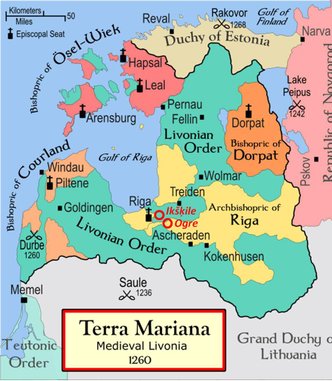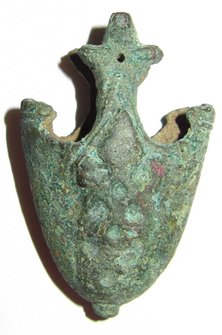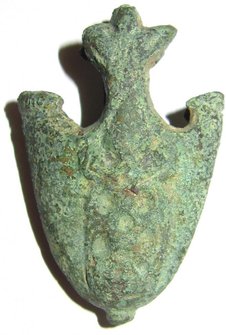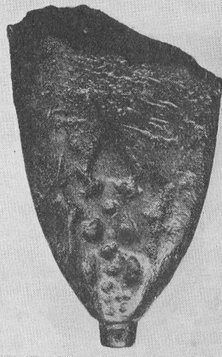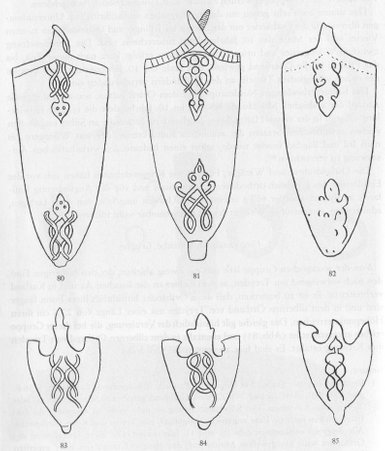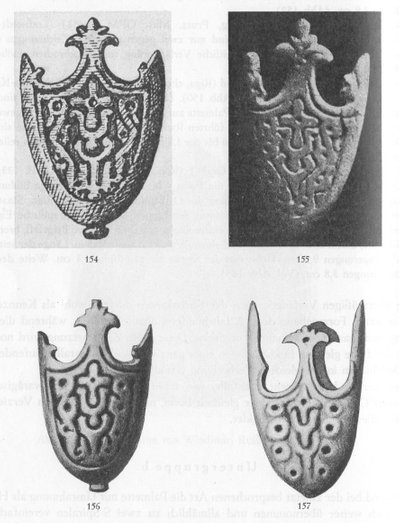The brave warriors of Livonia -
A short case study of a Baltic sword scabbard chape
This week's blog is a gueat blog, written by my friend Daniel from Germany, and sort of can be read as a sequel to the Blog of February 20th.
A travel to Daugava River.
The town of Ikšķile lies at the banks of Daugava river, 30 km southeast from Riga, modern Latvia. Near this town there is a city called Ogre. Yes, that's the name. But don't be afraid to travel there, you won't find huge man-eating beasts, but a romantic place rich of eels ("ugri" is Russian and means eel). There, Livonians and Latgallians (two of the ancient tribes of Latvia) lived together in the late Viking period. And these two places are where our journey takes us in this week's blog...
The chronicles of Latviešu Indriķis.
Henry of Latvia, or Latviešu Indriķis in Latvian language, was a German priest, historian and missionary who lived from the late 12th to the early 13th century and went to Latvia in 1205. There he witnessed the religious battles between the Teutonic Order and the Latvian tribes, who were not willing to give up their pagan rites and their land for the imposed Christendom. Between 1225 and 1227 Henry wrote the Chronicon Livoniae, where those battles are described. Within the chronicles, the historian mentions a war council of the Livonians, held in 1206 upon a hill nearby the city of Ogre.
Fig. 1: Territorial division of Livonia in 1260, highlighting today towns of Ogre and Ikšķile.
Remains of battle.
In the early 13th century, numerous battles between local tribes and the western invaders were fought in the region of Daugava river. The remains of one of those battles were found in Ikšķile, nearby Ogre, were the Livonian war council took place according to Henry of Latvia.
One of the items found there is the chape of a sword scabbard. The closed cast-bronze artefact measures 5.8 x 3.75 cm, a comparably small dimension. It has a tip on the bottom and ornaments on both sides. The lateral spurs show line ornaments and hardly visible traces of silvering. The central spur of each side ends in a triangular palmette, with a little hole in the center of only one side. This is interesting, as the Scandinavian counterparts are supposed to be fixed at the scabbard without nails or rivets.
However, few Baltic finds show similar means to attach the chape to the scabbard tip. Maybe the owner added this hole after the chape fell of the scabbard. The main ornaments show a triangular end, with a net of holes and lines below, ending in the bottom tip.
Fig. 2: Cast-bronze sword scabbard chape with palmette and Baltic-Varangian ornamentation (after Paulsen).
Where is this item from? - Approach of a revisited classification
The chape shown in Fig. 2 is remarkably rare, especially in this undamaged condition, and references are accordingly scarce. However, a damaged chape with exactly the same main ornament is known from Kiauten, East Prussia. It is shown in a book of Peter Paulsen [1].
Fig. 3: Left side - Ornament detail of sword scabbard chape of Baltic-Varangian group (no. 86), found in Kiauten, Kr. Samland, East Prussia (Photo from Prussia-Mus., Königsberg, former East Prussia).
Right side - examples for different expressions of chapes beloning to the Varangian-Baltic group: 80 - Bauske, Curonia, Latvia; 81 - Treyden, Livonia, Latvia; 82 - Alt-Rahden, Kr. Bauske, Curonia, Latvia; 83 - Kapenieki, Kr. Goldingen, Curonia, Latvia; 84, 85 - Katzdangen, Curonia, Latvia. (Taken from Paulsen, 1953).
Unfortunately this reference shows only the detailed photo of a chape with the upper part missing and one has to guess if it once had the same type of palmette as the one of Fig. 2. Presumably this is not the case, as there is a large area above the ornamentation left.
Although it was found in East Prussia, Paulsen classifies the chape ornamentation (Fig. 3, left) to the Varangian-Baltic group (see the blog entry from February 26th for more information). Chapes of this group are either of elongated or compact form. The chape discussed here belongs to a more compact type, represented best by picture no. 84 (Fig. 3, right side).
But, with special regard to the spurs, it is also similar to chapes from the Baltic-East Prussian group. Especially chape no. 155 shows similarities to the introduced object (Fig. 4). But unlike chape No. 84, it shows the same rugged ornamentation like the broken, originally elongated chape no. 86 (Fig. 3, left side).
Does the addressed chape shown in Fig. 2 represents a kind of "missing link"?
If Paulsen has had this object for the studies that led to his book, would he have re-classified the chape no. 86 as Prussian instead of Baltic-Varangian, in accordance with the fact that it was excavated in East Prussia? Or is it indeed a chape that can be classified as truly Baltic-Varangian? Anyhow it is, as well as the chapes no. 80-85, excavated in Latvia, and combines two characteristics that belong to this group, probably just not shown in a single object before.
The circumstance that the Baltic region had a dense net of tradeways during the late Viking period complicates a local classification of such objects. Wherever the chape of Ikšķile was crafted, the hybrid of the mysterious ornamentation and outer shape variations of sword scabbard chapes belonging to either the Baltic-Varangian group or a Curonian-East Prussian subgroup seems to be of scientific value. As some similar chapes were excavated in the province of Livonia, it seems also possible that this special style is a local Livonian expression influenced by the surrounding areas.
This would match the excavation site of the discussed object, Ikšķile, which belonged to the territory of the Livonian Order in the according time around the 12th and 13th century (Fig. 1). Although no other available literature but Paulsen's book describes a similar piece, it cannot be excluded that analogous artefacts were excavated. However, it could be truly unique.
Well. I could have been with these stones until after dark, but as my wife wanted to travel on.. well.. I see you again, some day, hogback stones from Gosforth. And if you happen to be there one day, do not forget that monument on the outside...
Further on with the Cumbrian hogbacktour !
In - yes, luckily again in - St. Peter's church in Heysham, there is a truly beautiful hogback stone. The guide told us, it had been studyied by Thor Ewing, a writer, in 2000. in 'Understanding the Heysham hogback' A tenth century sculpted stone monument and its context (link), Thor Ewing tells in detail what he dicovered on the both sides of this hogback stone.
Just being brought in the church as late as the 1970's accompanied with some protest here and there among the church visitors, considered as being a token of old paganism, it had been remarkably nice preserved, and a lot of detail can be seen, still. Truly worthwile a visit.
I had a small debate with the guide in the church if the - zoomorphic, in my opinion - faces on the sides were lions (or hippo's). The guide doubted if the vikings could have known about lions. Well I guess so, concerning the runes on the Ancient Greek lion statue at the Arsenal, Venice. For example. Vikings did travel south..
But when he told me he was doubting the vikings 'discovered' (as the native inhabitants were of course, in the first place) America before Columbus, I decided to rest my case..
One has to know when to start and to end a conversation ..
Just discovered the book in a bookstore written by Geoff Holder - The guide to the mysterious Lake District, I knew there had to be another hogback stone in Lowther, St. Micheal's Church. With a promising image described in the text of 'a naval and a land-based force of shield-bearing vikings above a fish and what might be a coiled sea serpent. On the reverse is a row of female figures with snakes, possibly a representation of the hideous hag Hel'. Wow. If that did not sound as a true pagan promised land ..
Not complaing too much after all we have seen, this visit was the dissapointing one of them all. But if you wife states 'I am happy to have seen them' and I am answering 'Measuring is knowing' and the even more obligate verb 'handling 'if we did not see it at all, we wouldn't have known anything at all of how they were looking' the glass was again half full, at the last day of our journey..
The hogback stone appeared to be just being tolerated within the entrance segment part of the church. As something you never use anymore but you do not throw away - entirely. That sort of feeling emerged when seeing this hogback asylum seekers.. Bed, bath and bread, ás we say in Dutch, but no luxury at all and standing on some outcuts of wood, you would balance the table with at home..
Come on, St. Micheal's Church.. care a bit more of your 'children' !
This hogback stone was moved in the church in 1907. Hogback stones layed partially buried in the churchyard before it was dug up and moved into the church.
The promising depiction of a longship - as certainly can be seen after some studying - see http://vikingminds.co.uk/pages/longship
we have missed !
The stone itself is (157 x 50 x 30 cm) and very worn.
The hogback stones in Cumbria - very diverse in quality, but everyone worth a visit ! Especially on a gloomy day in late October ...
The churches to visit - see photos of resp. St. Andrew's church in Penrith, St. Mary's church in Gosforth, St. Peter's church in Heysham and St. Micheal's church in Lowther.
Did I miss out on another one in Cumbria ? Let me know !
In a next blog I will take you to four - still remaining utterly mysterious- statues 'guarding' the graveyard of St. Andrew's church in Dacre..
For the last blog of October 9th see this link.
References: (as always, links to where the books can be ordered are attached).
Edwards, B.J.N. Vikings in North West England - The artifacts (1998);
Emery, Gordon, CURIOUS CUMBRIA, The Lake District & Beyond: A celebration of Cumbria (2023)
Ewing, T. 'Understanding the Heysham hogback' A tenth century sculpted stone monument and its context ;
Hall, R. Viking Age archaeology in Britain and Ireland (first printed 1990, reprinted with amendments in 1995);
Holder, G. The guide to the mysterious Lake District (2009)
possibly also (as there within the part of Cumbria dealing with Carlisle, the Eden Valley, Barrow-in-Furness, Whitehaven and the west coast is being dealed with)
Holder, G. Paranormal Cumbria (2010)
http://vikingminds.co.uk/pages/longship
Fig. 4: Examples of sword scabbard chapes from the Curonian-East Prussian group, subgroup b. 154 - Treyden, Livonia, Latvia; 155 - Dabrowo, Poznań, Poland; 156 - Treyden, Livonia, Latvia; 157 Passeln, Curonia, Latvia. (Taken from Paulsen, 1953)
It is not for sure if the sword scabbard chape of Ikšķile belonged to one of the brave warriors who tried to defend his homelands against the German invaders. If so, his efforts were in vain. The Teutonic Order was successful in occupying the region, which later developed to an important trading empire for wood and hemp until the 16th century. There are many other interesting objects telling us about the conflicts between ancient Latvian tribes and the Teutonic Order, but you may read more about this in the upcoming guest blogs...
References:
[1] Peter Paulsen, 1953: Schwertortbänder der Wikingerzeit.
W.Kohlhammer Verlag, Stuttgart, Germany
The Map image was taken from Wikipedia and edited, the copyright for Fig. 2 is entitled to the author of the current article, whom I gratefully thanks. due to busy other activities, enabling me to write a blog of my own this week.
Next week ? Maybe another intruiging guest-blog, maybe one of my hand..
Thomas Kamphuis, March 10th 2015.
